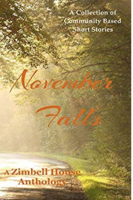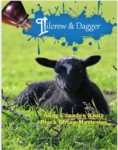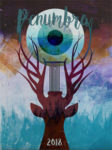
It’s fun sometimes to look back at how an idea germinates and — often too slowly — blossoms into a story. The seed of “Méchant” was an overactive little boy playing with a toy car while his overworked mother waited (with me and others) to see an orthopedic doctor at UConn Health Center. I imagined another patient volunteering to help with the little boy, and drafted a pretty good description of the setting. I tried calling it “Naughty Boy” and then “Novice Nana,” but it stubbornly refused to grow into a story with a narrative arc.
I set it aside, but came back to it with the notion of developing the novice nana into a frustrated woman who wished she had children of her own. From the start I’d given her enough French fluency to think of the little boy as méchant. I dimly remembered — had to look up — a more nuanced alternate meaning, not just naughty but wicked.
The theme for the next edition of Nightingale & Sparrow was renaissance, and I now had the novice nana entertaining wicked thoughts of her own rebirth. Perfect fit. Out now, available at Amazon with a bunch of other good short stories, or here at my blog

 earlier works, invited stories that developed a strong sense of community in a town that should be named November Falls. Place it anywhere, in any time, but make the community one that readers could readily identify and empathize with.
earlier works, invited stories that developed a strong sense of community in a town that should be named November Falls. Place it anywhere, in any time, but make the community one that readers could readily identify and empathize with.
 10,000-foot ranger station on 18,000-foot Mount Kenya — and were told of an American who’d gotten lost recently, in a stunted landscape prowled by buffalo, elephants, monkeys . . . and leopards.
10,000-foot ranger station on 18,000-foot Mount Kenya — and were told of an American who’d gotten lost recently, in a stunted landscape prowled by buffalo, elephants, monkeys . . . and leopards. published the first story I got into print after completing my Fairfield University MFA, “Consultants.” I tried them again; they liked it. It’s just out in Summer 2018 Issue #160. I got a paper copy in the mail today. For whatever reason, their online version isn’t posted yet, but you can read “Matches” ==>
published the first story I got into print after completing my Fairfield University MFA, “Consultants.” I tried them again; they liked it. It’s just out in Summer 2018 Issue #160. I got a paper copy in the mail today. For whatever reason, their online version isn’t posted yet, but you can read “Matches” ==> an idea spun into a short story that I knew would have limited or no appeal to the young adults, MFA students, who edit many of the country’s literary magazines. I sent it out to several anyway. No takers.
an idea spun into a short story that I knew would have limited or no appeal to the young adults, MFA students, who edit many of the country’s literary magazines. I sent it out to several anyway. No takers. was compiling an anthology of short stories on the theme “black sheep”. I had a story about an unwelcome mourner at a burial service, which I thought might fit. It did. Volume 4 Number 4 is available at Amazon and other booksellers, but you can read it now
was compiling an anthology of short stories on the theme “black sheep”. I had a story about an unwelcome mourner at a burial service, which I thought might fit. It did. Volume 4 Number 4 is available at Amazon and other booksellers, but you can read it now 
 May 2018 issue of the California-based Penumbra Art and Literary Journal, which includes my
May 2018 issue of the California-based Penumbra Art and Literary Journal, which includes my